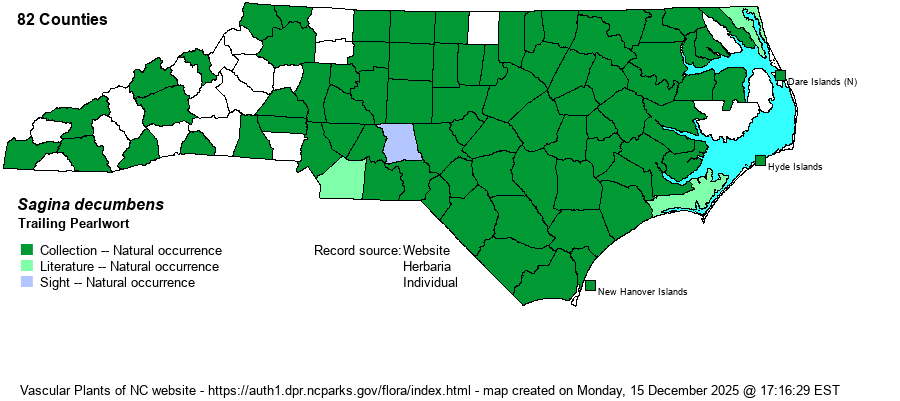| Section 6 » Order Caryophyllales » Family Caryophyllaceae |
Show/Hide Synonym
| taxonName | relationship | relatedTaxonName | relatedTaxonRefText | relComments |
|---|
|
|
|
|
|
|
|
|
|
|
|
| Sagina decumbens | = | Sagina decumbens ssp. decumbens | Flora of North America (1993b, 1997, 2000, 2002a, 2002b, 2003a, 2004b, 2005, 2006a, 2006b, 2006c, 2007a, 2009, 2010) | | | Sagina decumbens | = | Sagina decumbens ssp. decumbens | | | | Sagina decumbens | = | Sagina decumbens ssp. decumbens | Bittrich in Kubitzki, Rohwer, & Bittrich (1993). [also see Moenchia] | | | Source: Weakley's Flora |
|
| Author | (Elliott) Torrey & A. Gray | |
| Distribution | Present over nearly all of the Coastal Plain and Piedmont, but scattered in the Mountains. Perhaps absent in a few montane counties, but certainly is present in all counties downstate.
This is a widespread species in the Southeastern states, ranging from MA and KS south to central FL and central TX. | |
| Abundance | Common but easily overlooked in most of the Coastal Plain, but scarce toward the eastern coastal areas. Frequent to common in the eastern and central Piedmont, but infrequent in the western Piedmont and most of the Mountains. | |
| Habitat | This is a weedy native species that is quite ruderal in habitats. It occurs along roadsides, cracks in sidewalks, fields, and other disturbed places with very little competition from taller plants. | |
| Phenology | Blooms from March to June, and fruits soon after flowering. | |
| Identification | This is about as "insignificant" a native forb (non-grass, sedge, or rush) in the state as possible, and most biologists will overlook it because of its small and wispy look. It has numerous basal branches, and these are erect to spreading, but reach only about 3-4 inches tall or long. It has numerous paired linear leaves, each only about 1/3-1/2-inch long. At the ends of the branches are small flower clusters, with the sepals and 5 white petals barely 1/10-inch long at best. Though the petals are spreading, the open flower is barely 1/5-inch across, and more than likely you won't even see the flowers open. Thus, be prepared to identify this species by its very wiry branches, many from a common base, and numerous pairs of short and narrow leaves. Most people do not stop to look at "belly plants" in cracks of sidewalks, or along foot paths, but that is where it is often found. | |
| Taxonomic Comments | None
| |
| Other Common Name(s) | Eastern Pearlwort, Annual Pearlwort | |
| State Rank | S5 | |
| Global Rank | G5 | |
| State Status | | |
| US Status | | |
| USACE-agcp | FACU link |
| USACE-emp | FAC link |

